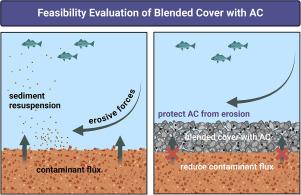Feasibility evaluation of a blended cover with activated carbon for in-situ stabilization of DDT in sediment
IF 3.5
3区 环境科学与生态学
Q2 ENVIRONMENTAL SCIENCES
引用次数: 0
Abstract
Activated carbon (AC) sediment amendment is an in-situ remediation technology in which the applied AC immobilizes organic contaminant flux from sediments, thereby reducing contaminant bioavailability and associated risks. While various studies have demonstrated the feasibility of in-situ AC treatment, hesitation to apply this technology exists due to limited experience under field-specific scour conditions and hydrodynamic forces. To address this concern, we conducted a feasibility study for an AC-blended cover at the Lauritzen Channel of the United Heckathorn Superfund Site in Richmond, California, United States, which was contaminated with dichlorodiphenyltrichloroethane and its metabolites (DDx) as well as dieldrin. Vessel activities causing sediment disturbance were identified as key factors for remedy selection. A blended cover with AC and coarse materials was designed to withstand varied hydrodynamic conditions and AC stability was tested in a current flume. The cover comprised medium-size gravel (D50 = 15 mm, D90 = 19 mm) with 4 % granular AC by weight. Flume erosion studies showed minimal AC loss (1–2 % of total AC) under shear forces of 9–31 Pa, which was equivalent to or exceeded the estimated worst-case erosional conditions in the channel induced by a hypothetical, stationary tugboat propelling at high power thrust. The treatability performance of the engineered blended cover design was evaluated through mesocosm studies using site sediment and various cover options. Post-treatment assessments on days 5 and 145 showed rapid reductions in freely dissolved (Cfree) DDx and dieldrin in the blended cover layers and surface water. For example, by day 145, Cfree DDx was reduced by over 98 %, meeting US EPA remedial goals for the site. It is concluded that the combination of both stability and performance testing demonstrates that an engineered blended cover-AC design would be a feasible remedial option at the site, and that this testing approach can be applied to evaluate in-situ treatment in other sediment cleanup activities.

用活性炭混合覆盖物就地稳定沉积物中滴滴涕的可行性评估
活性炭(AC)沉积物改良是一种原位修复技术,应用活性炭可固定沉积物中的有机污染物通量,从而降低污染物的生物利用率和相关风险。虽然各种研究都证明了原位活性碳处理的可行性,但由于在现场特定冲刷条件和水动力作用下的经验有限,人们对应用这种技术还存在犹豫。为了解决这一问题,我们在美国加利福尼亚州里士满的 United Heckathorn 超级基金遗址的劳瑞岑水道进行了 AC 混合覆盖的可行性研究,该水道受到二氯二苯三氯乙烷及其代谢物(DDx)以及狄氏剂的污染。造成沉积物扰动的船只活动被认为是选择补救措施的关键因素。设计了一种含有 AC 和粗粒材料的混合覆盖层,以承受不同的水动力条件,并在水流槽中测试了 AC 的稳定性。覆盖层由中等大小的砾石(D50 = 15 毫米,D90 = 19 毫米)和 4% 的颗粒状 AC(按重量计)组成。水槽侵蚀研究表明,在 9-31 Pa 的剪切力作用下,AC 损失极小(占 AC 总量的 1-2%),这相当于或超过了假定的静止拖船以大功率推力推进时在河道中造成的最坏侵蚀条件。通过使用现场沉积物和各种盖板方案进行中型宇宙研究,对工程混合盖板设计的可处理性进行了评估。第 5 天和第 145 天的处理后评估显示,混合覆盖层和地表水中自由溶解(不含游离碳)的 DDx 和狄氏剂迅速减少。例如,到第 145 天,不含 C 的 DDx 减少了 98% 以上,达到了美国环保局为该场地制定的补救目标。结论是,稳定性和性能测试的结合表明,工程混合覆盖层-AC 设计是该场址可行的补救方案,而且这种测试方法可用于评估其他沉积物清理活动中的原位处理。
本文章由计算机程序翻译,如有差异,请以英文原文为准。
求助全文
约1分钟内获得全文
求助全文
来源期刊

Journal of contaminant hydrology
环境科学-地球科学综合
CiteScore
6.80
自引率
2.80%
发文量
129
审稿时长
68 days
期刊介绍:
The Journal of Contaminant Hydrology is an international journal publishing scientific articles pertaining to the contamination of subsurface water resources. Emphasis is placed on investigations of the physical, chemical, and biological processes influencing the behavior and fate of organic and inorganic contaminants in the unsaturated (vadose) and saturated (groundwater) zones, as well as at groundwater-surface water interfaces. The ecological impacts of contaminants transported both from and to aquifers are of interest. Articles on contamination of surface water only, without a link to groundwater, are out of the scope. Broad latitude is allowed in identifying contaminants of interest, and include legacy and emerging pollutants, nutrients, nanoparticles, pathogenic microorganisms (e.g., bacteria, viruses, protozoa), microplastics, and various constituents associated with energy production (e.g., methane, carbon dioxide, hydrogen sulfide).
The journal''s scope embraces a wide range of topics including: experimental investigations of contaminant sorption, diffusion, transformation, volatilization and transport in the surface and subsurface; characterization of soil and aquifer properties only as they influence contaminant behavior; development and testing of mathematical models of contaminant behaviour; innovative techniques for restoration of contaminated sites; development of new tools or techniques for monitoring the extent of soil and groundwater contamination; transformation of contaminants in the hyporheic zone; effects of contaminants traversing the hyporheic zone on surface water and groundwater ecosystems; subsurface carbon sequestration and/or turnover; and migration of fluids associated with energy production into groundwater.
 求助内容:
求助内容: 应助结果提醒方式:
应助结果提醒方式:


